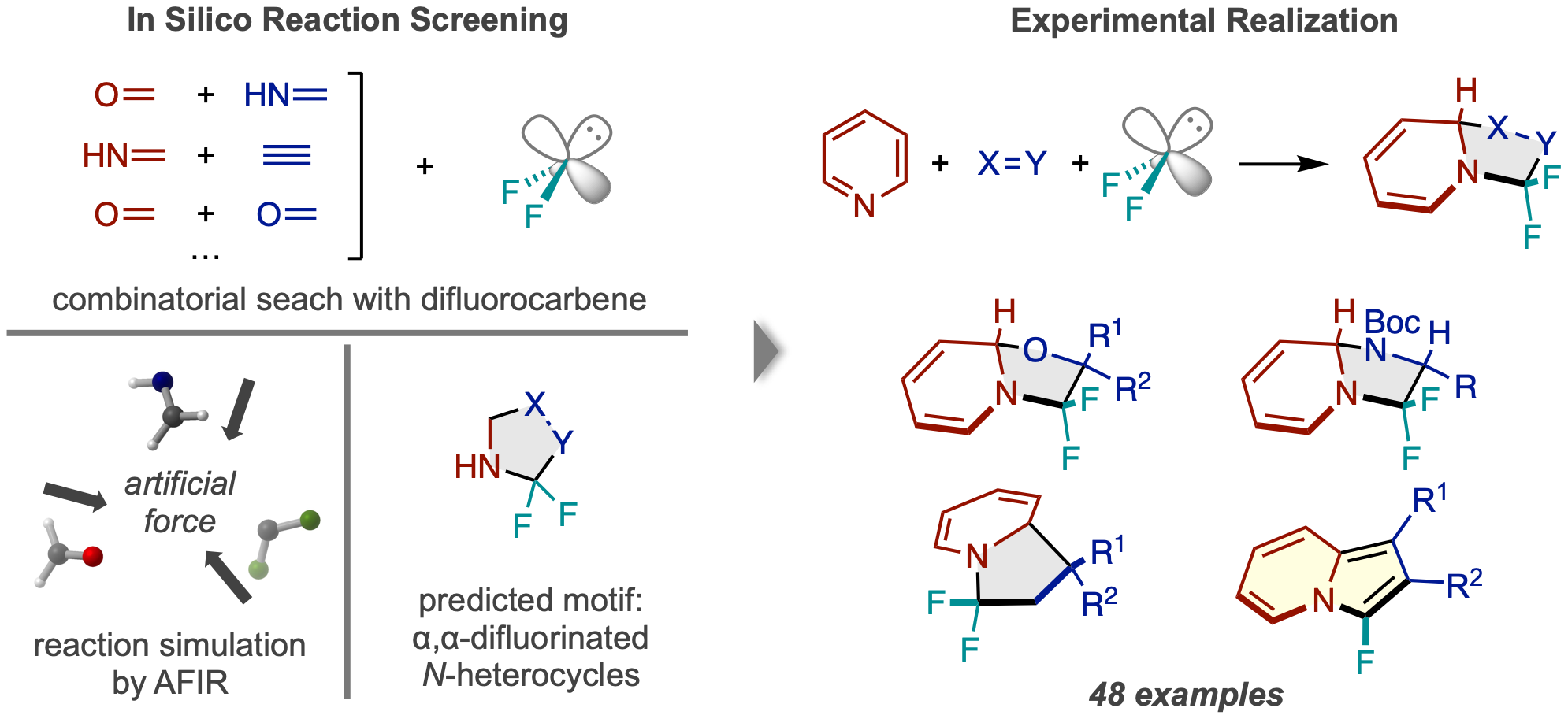Reviewed by Alex SmithAug 8 2022
Chemists frequently use computer simulations as a guide — much like a compass helps an explorer efficiently reach a destination on their map — to effectively work out the specifics of a basic reaction notion they have in mind.
 Workflow of reaction discovery via in silico screening. (Left) Reactions between difluorocarbene and numerous pairs of small molecules were simulated, predicting a N-heterocycle product fluorinated twice at the alpha carbon. (Right) The successful reaction framework using pyridine and examples of the types of product compounds obtained. (Hiroki Hayashi, Hitomi Katsuyama, Hideaki Takano, Yu Harabuchi, Satoshi Maeda, Tsuyoshi Mita. Nature Synthesis. August 08, 2022)
Workflow of reaction discovery via in silico screening. (Left) Reactions between difluorocarbene and numerous pairs of small molecules were simulated, predicting a N-heterocycle product fluorinated twice at the alpha carbon. (Right) The successful reaction framework using pyridine and examples of the types of product compounds obtained. (Hiroki Hayashi, Hitomi Katsuyama, Hideaki Takano, Yu Harabuchi, Satoshi Maeda, Tsuyoshi Mita. Nature Synthesis. August 08, 2022)
However, scientists at ICReDD went a little further and used simulations to generate the broad strokes of a very hypothetical reaction, essentially creating the map itself through computations. The team succeeded in creating a suite of 48 reactions that yield chemicals that could be useful for the creation of innovative drugs by using the design approach provided by computational results.
Fluorine’s presence and location in a molecule frequently influence that molecule’s pharmacological activity. To selectively add two fluorine atoms to a challenging location on an N-heterocycle — a molecule with a carbon ring structure where at least one carbon has been substituted with nitrogen — researchers at ICReDD have used quantum chemistry simulations.
The creation of a variety of innovative medications may result from the ability to connect fluorine atoms to the previously challenging “alpha carbon” — the carbon located close to the nitrogen in the ring structure.
The artificial force-induced reaction (AFIR) method was used to computationally test the viability of a large number of 3-component reactions before doing tests in the lab.
They recreated the interaction of different pairs of tiny molecules with double or triple bonds with a difluorocarbene molecule, which acts as the source of fluorine atoms. These computer simulations demonstrated that a variety of ring-forming processes ought to be possible.
The researchers attempted one of the potential reactions identified by the preliminary computer results, but they were unsuccessful. The difluorocarbene molecule reacted more readily with itself than with the required starting molecules, indicating that an unintended side reaction was probably taking place, according to a more focused, optimized estimate of the transition state energy of the reaction in question.
Researchers were motivated by this outcome to switch one of the initial components to the cyclic molecule pyridine, which they believed would be able to compete with the undesirable side reaction. With two fluorines connected at the alpha carbon position as a result of this modification, the intended N-heterocyclic product was successfully synthesized.
Due to the strong stability of aromatic systems, it is particularly challenging to change them, making the reaction demonstrated here significant because it fractures the pyridine molecule’s aromatic electron system.
Additionally, the 3-component reaction framework was effectively used in the lab to create numerous novel compounds with distinctive fluorine substitutions in the alpha position from a variety of different starting materials. The broad range of reactivity considerably increases the potential utility of this reaction framework in the discovery of novel drugs.
The researchers believe that their streamlined screening approach will enable them to expand the parameters of their search and uncover fresh possibilities for chemical reaction design.
Our study’s highlight is the successful demonstration of an in silico reaction screening strategy for reaction development. The computational reaction simulation suggested less-explored three-component reactions of difluorocarbene and two unsaturated molecules, which we successfully realized in experiments.
Hiroki Hayashi, Study Lead Author, Hokkaido University
“I think the AFIR method is a powerful tool for dictating new research directions in reaction discovery, and we plan to continue building a computation-based reaction development platform by integrating the computational and informatics techniques of ICReDD,” he added.
This work was funded by the Japan Science and Technology Agency (JST) through Exploratory Research for Advanced Technology (ERATO) grant JPMJER1903; the Japan Society for the Promotion of Science via KAKENHI Grants-in-Aid for Challenging Research (Exploratory) (21K18945), Scientific Research (B) (22H02069), and Young Scientists (20K15284).
Other sponsors also include the Central Glass Award in Synthetic Organic Chemistry, Japan; the NOASTEC foundation; the Akiyama Life Science Foundation; the Ube Industries Foundation; the Fugaku Trust for Medical Research; and the Uehara Memorial Foundation.
The Naito Foundation; and the Institute for Chemical Reaction Design and Discovery (ICReDD), which was established by the World Premier International Research Initiative (WPI), Ministry of Education, Culture, Sports, Science and Technology (MEXT), Japan, were also included.